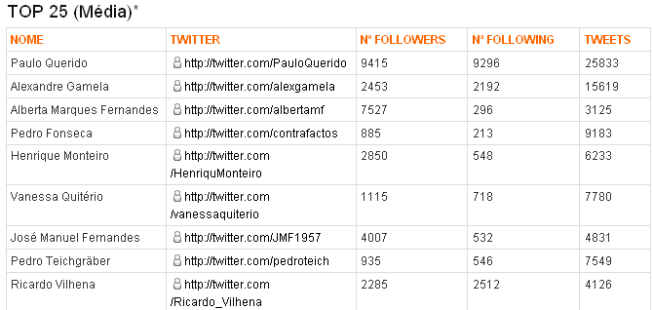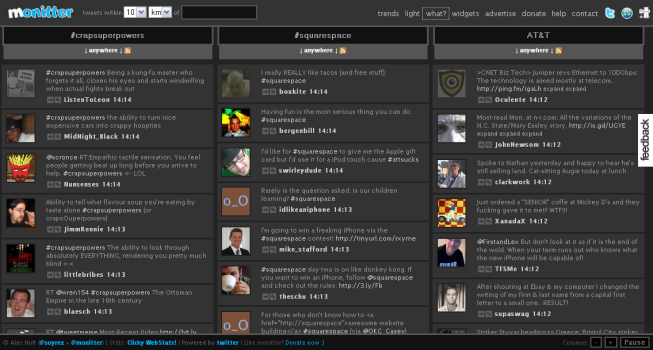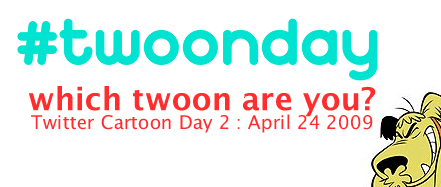Sorry all you english speaking people, but i don’t have time today to translate this. Maybe next week.
Estas são as perguntas da Ângela Marques para a sua reportagem sobre o Twitter que saiu no fim de semana passado no Semanário Económico. Como acho que ela levantou questões interessantes e eu dei algumas respostas com piada, vou publicar aqui o integral da entrevista.
1. Como conheceu o Twitter? Usa outras redes sociais como o Twitter (Facebook, Hi5, Myspace)?
Comecei a ouvir falar do Twitter na parte final de 2007, associado a outros serviços semelhantes como o Jaiku e o Plurk. Confesso que a início não fiquei fascinado com o microblogging, mas à medida que ia lendo alguns bloggers , como o Paul Bradshaw do OnlineJournalismBlog.com sobre esta ferramenta, fui ficando cada vez mais interessado. Além disso, era novo e gratuito,e achei que não custava nada experimentar. Acho que é assim que funcionam os early adopters.
Tive algumas dificuldades a princípio para entender o potencial do Twitter, mas à medida que ia entrando em contacto com outros utilizadores e a aumentar a rede de contactos esse potencial foi-se revelando. Acho que o ponto de viragem foi durante o incêndio de Camden Market há cerca de um ano, em que pelo Twitter estava a recolher mais informações e mais depressa do que pelos canais tradicionais, enquanto as partilhava com amigos meus em Londres, que nada sabiam do acontecimento. Depois com as aplicações que fui descobrindo, consegui ter uma utilização mais efectiva da aplicação. Na altura ainda dava para receber gratuitamente mensagens do Twitter no telemóvel, o que era o verdadeiro intuito do Twitter. A partir daí tornou-se realmente num vício.
Estou inscrito nessas três redes sociais, com uma presença mais efectiva no Facebook, mas a partir do Twitter achei-as limitadas, são na prática plataformas expositórias, enquanto que o Twitter na sua essência é uma ferramenta de partilha e diálogo.
2. O que lhe interessa no Twitter?
A interacção com as pessoas. Desenvolvem-se conversas, debates, partilham-se links, em 140 caracteres. Por muito pouco que tenhamos para dizer esse pouco pode ser valioso, tenho descoberto e aprendido muito com o que os elementos da minha rede de contactos partilham. Depois é a ubiquidade, demonstrada nos em alguns acontecimentos como a amaragem no Rio Hudson, onde a informação estava a ser divulgada por pessoas no local. Soma-se a isto a possibilidade de toda a gente ter telemóvel com câmara fotográfica, e haver uma evolução nos dispositivos móveis que permitem retirar o máximo do canal. Alguém partilha um dado com o seu grupo que é repetido exponencialmente pelos elementos desse grupo com os seus próprios seguidores e por aí fora. É o boca a boca à velocidade da luz, e é por isso que os media tradicionais têm ficado para trás em algumas situações porque precisam de enviar meios e pessoas para o local do acontecimento. Se alguém com Twitter estiver lá, o mundo também está.
Outro factor que me interessa imenso é o facto de as pessoas continuarem a agir como numa rede social tradicional: partilham as pequenas coisas do dia a dia, músicas, fotos, damos os bons dias, o que humaniza o relacionamento virtual. E depois, se alguém precisa de ajuda basta só pedir, alguém pode , ou tem alguém na sua rede que pode, ajudar. Existe um espírito muito solidário.
3. Por quantas pessoas é seguido no Twittter?
Graças à recente divulgação do Twitter houve um crescimento notório no meu número de followers, com 7 a 10 novos utilizadores a adicionarem-me por dia. Neste momento exacto tenho 716 mas espero chegar aos mil em menos de um mês. E são pessoas do mundo inteiro, mais ou menos ligados às minhas áreas de interesse, e muitos são amigos de amigos. Existe o FollowFriday que basicamente são tweets a recomendar algumas pessoas, todas as sextas. Já fui recomendado várias vezes, especialmente por utilizadores norte americanos. Há uma coisa que gosto de fazer cada vez que chega um novo follower que é dizer olá, tratá-lo pelo nome próprio, dar as boas vindas, e se através das bios ou dos links para os seus blogs eu vir que existe alguma coisa que interessa deixo sempre um comentário extra. Tenho a noção que são pessoas reais do outro lado e dizer olá é o mínimo que posso fazer já que se interessaram por aquilo que eu digo em 140 caracteres.
4. (Vamos tentar fazer uma pergunta sem a palavra Twitter?) Continua a
alimentar o seu blogue com a mesma frequência?
Mais ainda. Tenho mais público no Twitter do que um dia normal de visitas no blog, e muitos chegam aos meus posts lá, porque são notificados através do Twitter que escrevi mais alguma coisa. Depois quem achar o texto suficientemente interessante para ser partilhado, reenvia o meu link para a sua rede. É um processo viral, que me tem dado mais visibilidade ao meu trabalho como blogger. O que acabo por fazer de diferente é partilhar mais links via Twitter do que recomendá-los no blog.
5. Quantos Twitters segue?
Essa é a parte curiosa na minha construção da rede de contactos no Twitter. São cerca de menos 30, em média do que o meu número total de seguidores. Neste momento são 691. Isto acontece porque há utilizadores que ou não disponibilizam dados suficientes ou não vejo interesse em segui-los, tenho algum cuidado em filtrar os meus contactos. Mas procuro sempre que seja um número equilibrado e normalmente sigo de volta todos os novos followers. Há utilizadores, especialmente aqueles com um perfil público notório – actores, comediantes, músicos etc- que não seguem quase ninguém de volta. Eu por um lado percebo, mas por outro o Twitter não é um palco, é uma plataforma de intercâmbio. Eu não quero falar com ninguém que não queira saber do que eu digo. O mais interessante é que nessas quase 700 pessoas que eu sigo, eu adicionei por iniciativa própria menos de 50, não porque não tenha interesse em fazer mais contactos, mas porque as pessoas têm vindo naturalmente a adicionar-me. Ainda não atingi um número crítico de pessoas que seja difícil de seguir e filtrar a informação, mas às vezes há muita coisa a acontecer ao mesmo tempo. Mas há quem lide bem com mais de vinte mil fontes de informação no Twitter, por isso acho que não me posso queixar.
6. Como analisa o aumento do número de utilizadores do Twitter no último mês?
É o reflexo natural da divulgação da plataforma entre os utilizadores comuns e claro, entre os jornalistas, que começam a usar e a falar cada vez mais do Twitter. É uma ferramenta que é fácil de usar e devido às ligações que se estabelecem dentro da rede de contactos torna-se viciante. Há encontros de utilizadores do Twitter, como disse , há um lado humano muito forte dentro desta rede social. E espero que os operadores móveis reparem nisso e comecem a apostar no Twitter, eu apostei há uns meses com o Paulo Querido que no espaço de um ano iria aparecer um telemóvel com uma tecla específica para usar o Twitter. E eu não quero perder.
Continue a ler ‘Entrevista completa ao Semanário Económico’


























Comentários Recentes